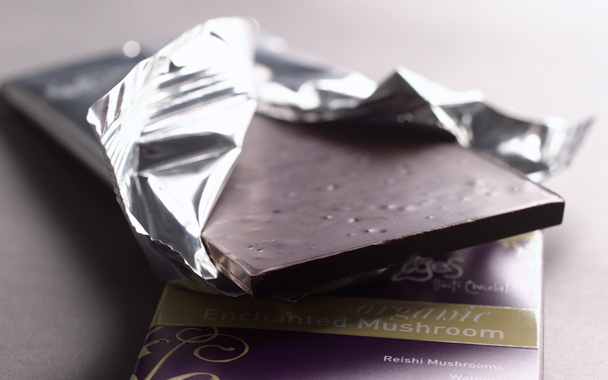Unlike the sales of everything else these days—morning lattes, pricey dinners, corporate jets—the sales of chocolate are booming. And with the uptick in demand, chocolatiers are throwing experimentation into overdrive. Whereas ingredients like Aztec chili, cardamom and fennel used to be considered exotic, the current urge to shock and awe—and still be edible—is creating a weird sort of chocolate arms race, with chocolatiers trying to one-up each other in outrageousness.
This is something I realized unintentionally while in Toronto for business. I decided to shake off some conference-room-induced sensory deprivation with a trip to Soma, a boutique chocolate factory in the Distillery District. When I entered, the heady scent of freshly conched cacao hit me in the face, resuscitating me with visions of single-origin bars and classic truffles. Soma had those in spades. But as I studied the case of handcrafted bonbons, more intriguing flavors jumped out: balsamic vinegar, Spanish olive oil, Douglas fir. Douglas fir? That I had to try.
The conical-shaped bonbon boasted a gorgeously tempered shell—so elegant I had to stop and admire it before taking a bite. Or maybe I was just steeling my nerves. The chocolate had a nice snap, and the ganache was decadently rich, but when the coniferous essence hit me, I couldn’t help but think my truffle had been accidentally sprayed with pine cleaner.
While it wasn’t the most pleasant experience I’ve ever had, it made me curious to explore the latest crop of bizarre chocolate combinations. Surely this arms raced has produced something worth eating for more than just the sheer novelty, right? From the Manhattan-based Chocolat Moderne, I found a Kalamata olive bonbon: a pretty green and white airbrushed shell hiding a soft caramel filling made with Kalamata olives, sea salt, and olive oil. With the briny center and dark chocolate balancing each other, it was just crazy enough to work.
Then I came across smoky blue chocolate truffles from Lillie Belle Farms in Oregon and ordered a box, imagining great stinky balls of gooey cheese and chocolate. Instead, I got quaintly hand-rolled, almond-crusted truffles. Made with Rogue Creamery’s smoked Oregon blue, they had none of the pungency of the pure cheese, just a faint tang that tickled the back of my tongue before being chased by the sweetness of chocolate and sugar.
Speaking of unusual dairy-chocolate pairings, of the dozens of outlandish flavors (or “culinary cult objects”) that Austrian chocolate maker Zotter produces, the most cringe-worthy is the bar made with a blend of horse’s and goat’s milk—not exactly something I imagine chocoholics are clamoring for.
Same goes for the new Enchanted Mushroom bar by Vosges, the chocolatier responsible for sparking this whole trend with its Mo’s Bacon Bar, released in 2007. The chocolate and bacon combo I get, but aren’t mushrooms better paired with, say, barley or polenta?
When I first bit into the thin, crisp bar, the mushroom flavor was buried amid walnut bits and 66-percent cacao. But as it lingered on my tongue, the faint taste of wet forest floor came through—not my favorite flavor in the world. The packaging extols Reishi mushrooms as a “superfood.” But having them in a chocolate bar reminded me of hiding peas in your mashed potatoes: a way to trick yourself into eating something you really don’t want to.
What’s next? As European influences waft across the Atlantic, we’ll see the stakes rise even higher. To wit: Belgian “shock-o-latier” Dominique Persoone recently unveiled a cauliflower chocolate. Maybe there’s something to be said for tree-oil-flavored bonbons, after all.



 Pinterest
Pinterest


